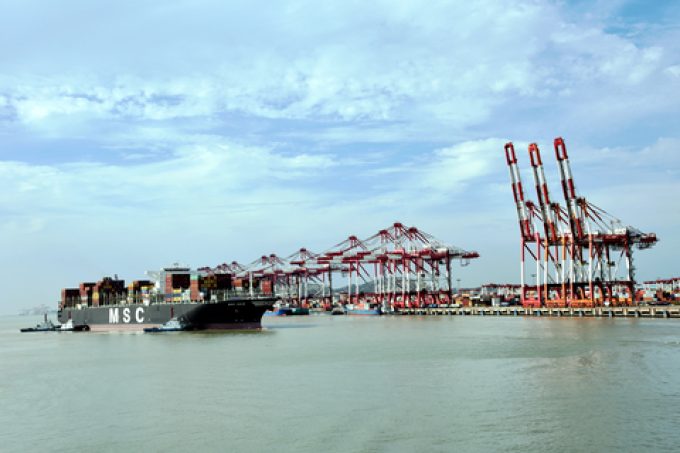WSC appoints Soren Toft and Randy Chen as new chair and vice chair
MSC boss Soren Toft and Randy Chen, vice chairman of Wan Hai, have become chair ...
FDX: ABOUT USPS PRIVATISATIONFDX: CCO VIEWFDX: LOWER GUIDANCE FDX: DISRUPTING AIR FREIGHTFDX: FOCUS ON KEY VERTICALFDX: LTL OUTLOOKGXO: NEW LOW LINE: NEW LOW FDX: INDUSTRIAL WOESFDX: HEALTH CHECKFDX: TRADING UPDATEWMT: GREEN WOESFDX: FREIGHT BREAK-UPFDX: WAITING FOR THE SPINHON: BREAK-UP ALLUREDSV: BREACHING SUPPORTVW: BOLT-ON DEALAMZN: TOP PICK
FDX: ABOUT USPS PRIVATISATIONFDX: CCO VIEWFDX: LOWER GUIDANCE FDX: DISRUPTING AIR FREIGHTFDX: FOCUS ON KEY VERTICALFDX: LTL OUTLOOKGXO: NEW LOW LINE: NEW LOW FDX: INDUSTRIAL WOESFDX: HEALTH CHECKFDX: TRADING UPDATEWMT: GREEN WOESFDX: FREIGHT BREAK-UPFDX: WAITING FOR THE SPINHON: BREAK-UP ALLUREDSV: BREACHING SUPPORTVW: BOLT-ON DEALAMZN: TOP PICK

There was more evidence in this week’s container port freight markets that peak prices on the main east-west deepsea trades have passed.
All three major indices recorded single-digit declines on the back of lower utilisation of ships loading in Asia.
The most significant drops were seen on the transpacific Asia-North America route, where Drewry’s World Container Index (WCI) Shanghai-Los Angeles declined 5% week on week, to yesterday’s level of $6,934 per 40ft, while Xeneta’s transpacific XSI saw a 6% drop, to $7,322 per 40ft, and the Freightos FBX dropped 4%, to $7,738 per 40ft.
Meanwhile, pricing on the Asia-North Europe route was either flat or saw slight declines: the WCI and XSI were flat, at $8,260 and $8,474 per 40ft respectively; while the FBX dropped 2% week on week, to finish at $8,420 per 40ft.
Asia-Europe freight forwarding sources confirmed that space over the past fortnight had become easier to procure, suggesting that either demand has begun to wane, or that the large-scale capacity additions since the beginning of the year are finally beginning to make their presence felt.
“It has definitely become easier to get space in the past two weeks, although we are still being held to allocation, and anything over that is having to move to spot/FAK pricing,” one forwarder told The Loadstar this morning.
The WCI’s Shanghai-Genoa leg saw spot rates decline 1%, to finish at 7,645 per 40ft, while the FBX’s Asia-Mediterranean trade was down 3% week on week, to $7,508 per 40ft.
Every major carrier – with the exception of Yang Ming – has seen capacity increase in the first half of the year, according to data from Alphaliner this week, with MSC leading the way, adding around 400,000 teu to its fleet since January, breaching 6m teu fleet-wide capacity.
There is a lot more to come: both MSC and CMA CGM have around 1.2m teu of capacity on order across this year and next, and Alphaliner noted “there is good chance” the French carrier will surpass Maersk to become the second-largest carrier within the next two-to-three years.
Meanwhile, the spot freight rate declines bring to an end more than three months of consecutive spot rate increases, and this has begun to bleed into the charter market, with this week’s Hamburg and Bremen Shipbrokers Association (VHBS) commentary noting carriers becoming increasingly cautious in negotiations with owners.
VHBS director Alexander Geisler wrote: “This prudence is legitimate, considering that spot cargo rates are weakening; the SCFI registering last Friday its second week of fall, after 13 weeks of uninterrupted rise.
“The continued injection of newbuilding capacities is slowly eroding the market’s current strong fundamentals.
“The reduction in cargo demand, which might happen sooner than expected this year, considering an early start of the peak season will test the market’s resilience to the abundance of new ships.
“With more than 1.3m teu of new vessels yet to be delivered by the end of the year, and a further 2m teu in 2025, there could be some turbulent times further down the road for owners and operators,” he added.
Comment on this article